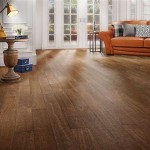Interior Design Considerations for Dark Wood Floors
Dark wood floors possess an enduring appeal, lending a sense of sophistication, warmth, and grounding to any interior space. Their rich tones can create a dramatic statement or subtly enhance an existing décor. However, successfully integrating dark wood floors into an interior design scheme requires careful consideration of color palettes, lighting, furniture choices, and accent pieces to prevent the space from feeling oppressive or visually small.
The selection of dark wood flooring itself is a crucial first step. Options range from naturally dark hardwoods like walnut, ebony, and wenge to lighter woods stained to achieve the desired depth of color. The specific shade of darkness and the grain pattern of the wood will significantly impact the overall aesthetic. A flooring sample should always be viewed in the specific room's lighting conditions before a final decision is made. Consider the existing architectural style of the property. A traditional home may benefit from a dark wood with a pronounced grain, while a more modern setting might call for a smoother, more uniform surface.
Balancing Light and Dark: Color Palettes for Dark Wood Floors
One of the primary challenges of designing with dark wood floors is maintaining a sense of brightness and openness. The floor's darkness can absorb light, potentially making the room feel smaller and less inviting if not balanced effectively. Therefore, the selection of wall colors, furniture fabrics, and accent elements plays a vital role in achieving a harmonious design.
Light and neutral paint colors are frequently favored in rooms with dark wood floors. Whites, creams, and light grays reflect light and counterbalance the floor's darkness, creating a sense of spaciousness. Off-white shades with warm undertones, such as ivory or antique white, can introduce a feeling of warmth and comfort, while cooler grays can create a more contemporary and sophisticated ambiance. The specific undertone should be carefully considered in relation to the wood's tone, avoiding clashes and ensuring visual harmony.
Pastel colors can also work well, particularly in bedrooms or nurseries. Soft blues, greens, and pinks provide a gentle contrast to the dark flooring and create a calming atmosphere. However, it is important to avoid overly saturated or bright pastels, which can appear childish or overwhelming against the dark wood.
While light colors are generally recommended, darker hues can be used strategically to create a dramatic effect. Deep blues, greens, or even blacks can be incorporated as accent walls or in smaller rooms to create a sense of intimacy and sophistication. However, it is essential to use dark colors sparingly and to ensure that the room has ample natural light or well-placed artificial lighting to prevent it from feeling claustrophobic.
The selection of furniture fabrics should also complement the floor's color and the overall color scheme. Light-colored upholstery, such as linen, cotton, or velvet in shades of white, cream, or light gray, can provide a striking contrast to the dark wood and create a visually appealing balance. Textural fabrics can add depth and interest to the space, preventing it from feeling flat or one-dimensional. Consider incorporating patterns with light and dark elements to tie the room together.
Illuminating the Space: Lighting Strategies for Dark Wood Floors
Effective lighting is critical in rooms with dark wood floors. Because these floors absorb light, it is essential to layer lighting sources to ensure that the space is adequately illuminated and that the darkness of the floor does not create shadows or a gloomy atmosphere. A combination of ambient, task, and accent lighting should be incorporated to create a well-lit and visually appealing environment.
Ambient lighting, which provides overall illumination, can be achieved through overhead fixtures such as chandeliers, pendant lights, or recessed lighting. For rooms with low ceilings, flush-mount or semi-flush-mount fixtures can provide adequate ambient light without visually lowering the ceiling. Consider using dimmer switches to control the intensity of the ambient lighting, allowing adjustment based on the time of day and the desired mood.
Task lighting, which provides focused illumination for specific activities, is essential in areas such as reading nooks, desks, or kitchen islands. Table lamps, floor lamps, and adjustable task lights can provide targeted illumination where it is needed most. Position task lighting strategically to avoid glare and shadows, ensuring comfortable and efficient use of the space.
Accent lighting is used to highlight specific features or objects in the room, such as artwork, architectural details, or decorative accessories. Spotlights, track lighting, or wall sconces can be used to draw attention to these focal points and add depth and dimension to the space. Consider using accent lighting to highlight the texture and grain of the dark wood floor, adding visual interest and warmth.
The color temperature of the light bulbs used can also impact the overall ambiance of the room. Warm white light bulbs (2700-3000K) can create a cozy and inviting atmosphere, while cool white light bulbs (3500-4100K) can provide a brighter and more energizing feel. The specific color temperature should be chosen based on the room's function and the desired mood.
Mirrors can also be used to enhance the lighting in a room with dark wood floors. Mirrors reflect light and create the illusion of more space, helping to brighten the room and visually expand its dimensions. Position mirrors strategically to reflect natural light or artificial light sources, maximizing their effectiveness.
Furniture and Accessories: Complementing Dark Wood Floors
The selection of furniture and accessories is critical to complementing dark wood floors and creating a cohesive and visually appealing interior design. The furniture's style, material, and color should be carefully considered in relation to the floor's tone and the overall design aesthetic.
Light-colored furniture, such as white, cream, or light gray sofas, chairs, and tables, can provide a striking contrast to the dark wood and create a visually balanced space. Upholstered furniture in natural materials like linen or cotton can add texture and warmth, while sleek furniture in modern materials like metal or glass can create a more contemporary look. The scale of the furniture should also be proportionate to the size of the room, avoiding overly large or bulky pieces that can overwhelm the space.
Wood furniture can also be used in rooms with dark wood floors, but it is important to choose a wood tone that complements the floor's color. Lighter wood tones, such as maple, birch, or ash, can provide a pleasing contrast to the dark wood, while darker wood tones, such as walnut or cherry, can create a more monochromatic and sophisticated look. Avoid using furniture in the exact same shade as the floor, as this can create a visually flat and uninteresting space.
Metal accents, such as brass, gold, or silver, can add a touch of elegance and sophistication to rooms with dark wood floors. Metal frames, lighting fixtures, and decorative accessories can provide a striking contrast to the dark wood and add visual interest to the space. Consider using metal accents sparingly to avoid creating an overly cold or sterile atmosphere.
Area rugs can be used to define different areas within the room and add texture, color, and pattern to the space. Light-colored rugs, such as white, cream, or light gray, can brighten the room and provide a soft and comfortable surface underfoot. Rugs with geometric patterns or bold colors can add visual interest and personality to the space. The size of the rug should be proportionate to the size of the room and should be large enough to anchor the furniture in the seating area.
Decorative accessories, such as throw pillows, blankets, artwork, and plants, can add the finishing touches to the room and create a personalized and inviting space. Choose accessories that complement the overall color scheme and design aesthetic, and consider incorporating textures and patterns to add depth and interest. Plants can add a natural element to the room and help to purify the air, while artwork can add personality and visual interest. Avoid over-cluttering the space with too many accessories, as this can create a sense of chaos and disorder.
In summary, designing with dark wood floors requires a careful balance of light and dark elements. By paying attention to color palettes, lighting strategies, and furniture choices, one can create a space that is both visually stunning and functionally comfortable. Regular maintenance is also essential to preserve the beauty and longevity of the dark wood floors, including regular sweeping, vacuuming, and occasional professional cleaning and refinishing. With proper care and attention to detail, dark wood floors can serve as a beautiful and enduring foundation for any interior design scheme.

Design Considerations For Dark Wood Flooring In Your Interior Décor Carlisle Wide Plank Floors

What Goes With Dark Wood Floors William Pitt Sotheby S Realty

What Colours Pair Well With A Dark Wood Floor In Your Living Room French Manufacturer Of Designer Wooden Flooring Panaget

Interior Design Ideas Dark Wood Floors

Dark Wood Floors In Scandinavian Designs

Transform Your Living Room With These 36 Stunning Dark Wood Floor Designs

Beginners Guide To Hardwood Floors And Interior Design Square One

Designers Top Tips For Finding Your Ideal Hardwood Flooring

Dark Parquet Flooring In Interior

Design Considerations For Dark Wood Flooring In Your Interior Décor Carlisle Wide Plank Floors








